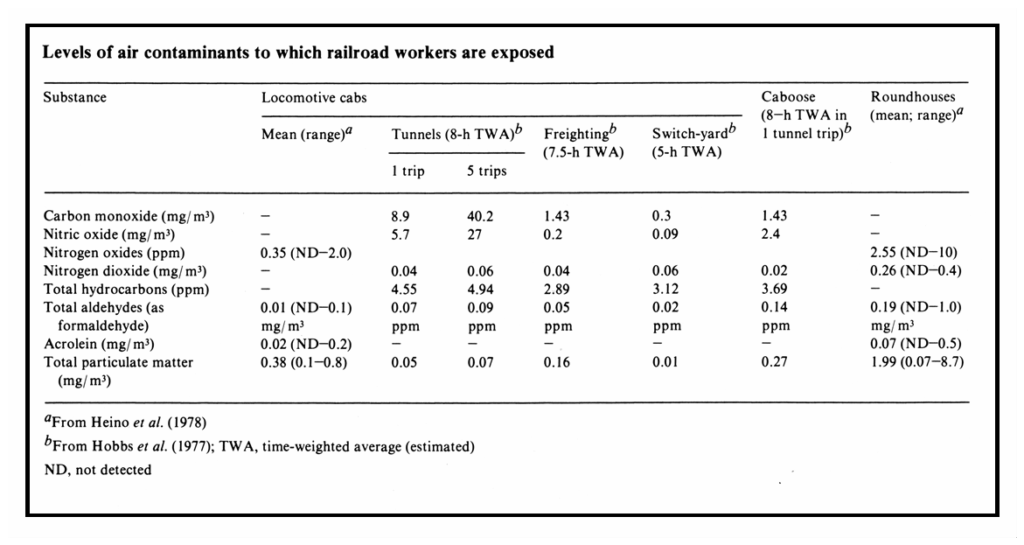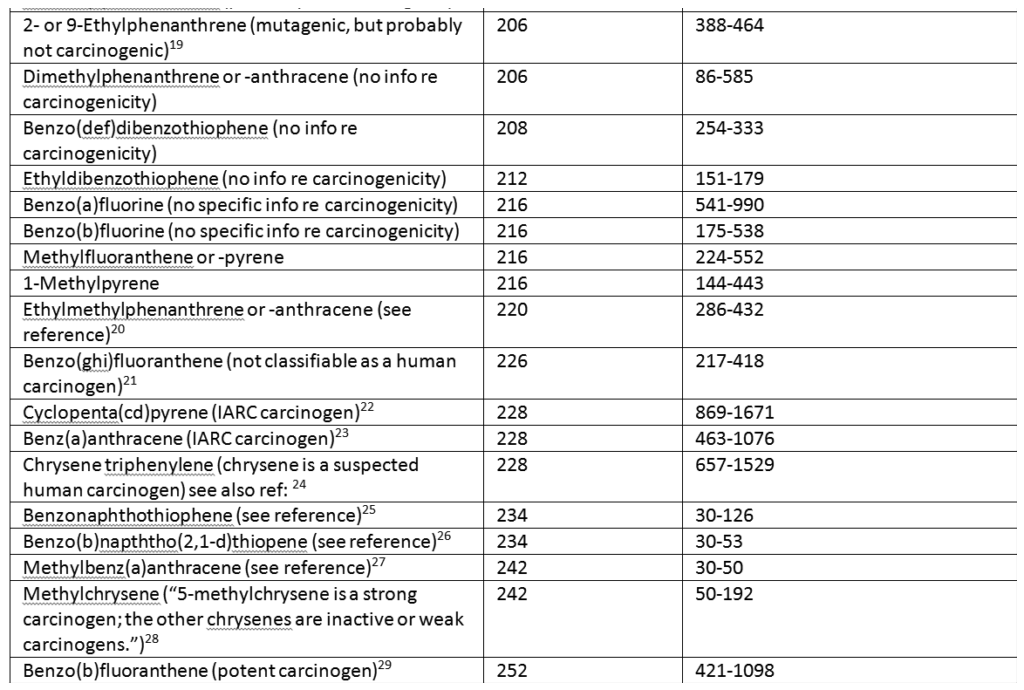Diesel Exhaust

.
What to know:
On June 12, 2012, the International Agency for Research on Cancer (IARC), part of the World Health Organization (WHO) classified diesel engine exhaust as carcinogenic to humans (Group 1), based on “sufficient evidence that exposure is associated with an increased risk for lung cancer.”1
Diesel particles are extremely small, virus-sized spheres of carbon coated in complex hydrocarbons, many of which are carcinogens.
Swedish researcher Jenny Rissler, in her 2012 paper suggested that it isn’t the mass of the particles that are important biologically, but rather the total surface area of the diesel particulate inhaled. In the paper, she estimated that one cubic micrometer of diesel particulate has an equivalent surface area of between 8.3 +/- 2.5 and 11.4 +/-3.8 square millimeters.2
Since Rissler’s results were experimentally derived using nitrogen analysis, it suggests that there is an abundance of smaller diesel particles that would possibly increase the surface area result significantly.
In the past, locomotives have typically used Number 2 diesel fuel (often referred to as ‘2D’. In very cold weather, the locomotive may use Diesel Number 1.3 It should be obvious that diesel exhaust is the result of burning diesel fuel. As of 1991-2005, a stretch of time that included the first Gulf War, diesel fuel could include the following ingredients4:
• ignition improvers/cetane enhancers,
• smoke suppressors/combustion enhancers,
• detergents,
• flow improvers,
• cloud-point depressors,
• wax anti-settlers,
• static inhibitors,
• corrosion inhibitors,
• antioxidants,
• anti-foam agents,
• de-hazers,
• biocides,
• lubricants, and,
• odor maskers.
In an experiment conducted by the National Institute of Occupational Safety and Health (NIOSH) researchers Inoka Eranda Perera and Charles D. Litton found that No. 2 diesel fuel produced the highest density smoke.5 In a paper presented at the Proceedings of the 17th Arctic and Marine Oil Spill Program (AMOP) Technical Seminar, Vol. I. June 8-10, 1994, William D. Walton (NTIS) and Robert R. Hiltabrand (US Coast Guard), reported that smoke particulate from diesel fuel fires on water ranged from 9 to 14% of the mass of fuel burned.6 They also reported the cumulate mass of particulate below 9.8 microns in diameter as measured by the cascade impactor was 84% for burn 1019, 79% for burn 1022a and 71% for burn 1022b.”7 In other words, the majority of diesel particulate produced by burning was smaller than 9 microns.
Diesel exhaust not only produces soot, but it also includes a group of chemicals called nitroarenes into the atmosphere. Volume 46, published in 1986 by the International Agency for Research on Cancer, included this table: Levels of air contaminants to which railroad workers are exposed. 8, 9
Carbon monoxide is a chemical that is termed a chemical asphyxiant because it blocks the cells in the body from absorbing oxygen. Nitrogen oxide and nitrogen dioxide are chemical irritants. Formaldehyde is both a carcinogen and an irritant. Acrolein is also an irritant and is considered by the International Agency for Research on Cancer (IARC) as probably carcinogenic to humans.
The diesel particle itself is basically a sphere of carbon with a diameter between 0.01-0.08 microns. (10 – 80 nanometers). Note: 1 micron = 1000 nanometers. For comparison, a Covid-19 virus particle is between 0.07 microns to 0.09 microns in diameter (70-90 nanometers)10, 11 The carbon cores of the diesel particles are each surrounded by hydrocarbons. These particles then combine to form groups of soot “agglomerates” ranging in size from 30-500 nanometers in diameter, with the largest concentration usually found between 100 and 200 nanometers in diameter.12
If the nanoparticle is inhaled, then these chemicals surrounding the central carbon core are inhaled with it and are subsequently released inside the body13.
Metals
In addition to chemicals such as polynucleated aromatics (PNAs) in diesel exhaust, there are metals. Among the most abundant, is iron (Fe)–contributing about 43 percent of the total metal particulates found in diesel exhaust. One study found 2.3-3.9 micrograms per cubic meter (µg/m3) of iron in diesel exhaust. Other metals found include lithium, vanadium, lead, arsenic and cadmium.14 Giordano et al (2010)15 reported copper, iron, sodium, nickel, zinc, aluminum, chromium as well as silica fibers. The authors concluded that the source of the silica fibers, however, was from the catalytic converter on the rail diesel engine used in the experiment. They also believed that the metals could have originated in the “abrasion processes” inside the engine as well as from “additives in lube oil and fuel.”
In one of my recent FELA cases, a medical expert using a scanning electron microscope and energy dispersive x-ray spectroscopy found three particles in the plaintiff’s lungs that contained the metal cerium. Cerium is an interesting element. It is named for the asteroid Ceres, which in turn was named for the Roman goddess of agriculture. It was found as a component of nuclear fallout from the 1950s atmospheric tests, but these days, cerium is ordinarily found in flat-screen televisions, low-energy lightbulbs, inside the walls of self-cleaning ovens and in catalytic converters. The element cerium is also found in fuels used in diesel locomotives as a ‘fuel-borne catalyst’ that lowers the generation of diesel exhaust particles16 The cerium itself is found in the diesel exhaust as nano-sized particles of cerium oxide (CeO2).
Jane Y.C. Ma et al., in a 2014 paper, “Interactive effects of cerium oxide and diesel exhaust nanoparticles on inducing pulmonary fibrosis,”17 reported that cerium oxide used as a diesel fuel catalyst may “cause health concerns,” specifically, be a factor in pulmonary fibrosis.
Diesel particles are nanoparticles–with all the nanoparticles’ attendant hazards
Additionally, since the diesel particles are so small–literally smaller than a virus particle, these objects can travel from the lung into the rest of the body via the capillary network18, 19.
A 2002 article by Gunter Oberdorster and Mark J. Utell suggested that nanoparticles may possibly travel to the central nervous system via nerve tracts20. And, of course, the smaller the particle, the more difficult it will be for the lung to clear (remove) it 21, 22, 23
(c) Legis Corp 2025. All rights reserved.
NOTE: To request the full document with end notes, use the Contact Form on this website and ask for “Diesel Exhaust doc I.”



